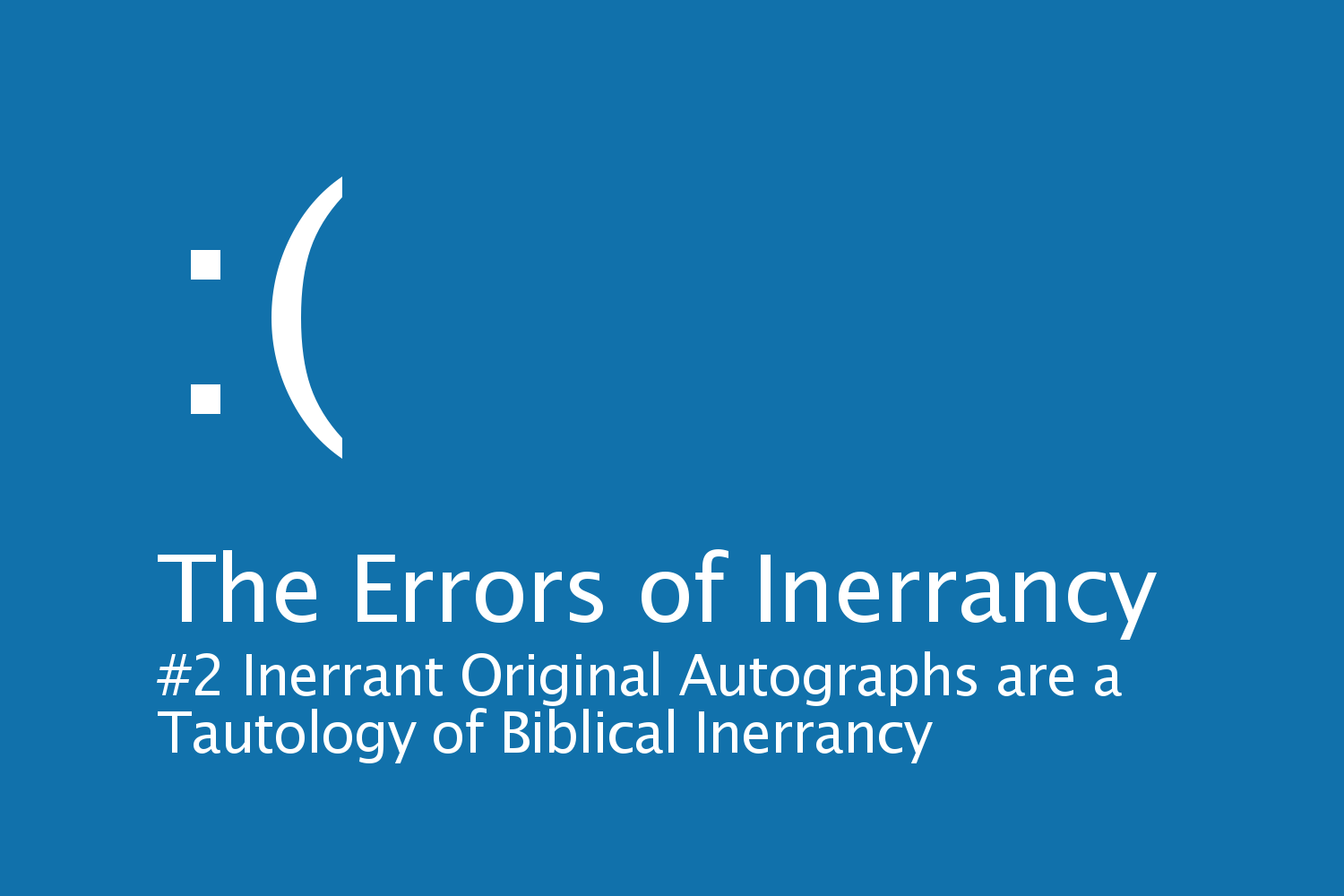 [The Errors of Inerrancy: A ten-part series on why Biblical Inerrancy censors the Scriptures and divides Evangelicals.]
[The Errors of Inerrancy: A ten-part series on why Biblical Inerrancy censors the Scriptures and divides Evangelicals.]
The Errors of Inerrancy: #2. Inerrant Original Autographs are a Tautology of Biblical Inerrancy
What are Inerrant Original Autographs?
The Inerrant Original Autographs are the linchpin of Biblical Inerrancy, but what are these hypothetical documents? I'll answer by reviewing the history of it.
According to the rationalistic logic of Biblical Inerrancy, God may not error, and God may not speak error, and so the syllogism concludes that if there is even an insignificant error in the Bible, then the Bible is not the Word of God. The first proponents of Biblical Inerrancy in the 17th century, including Francis Turretin and John Owen, extended inerrancy to the scribal copy-work of Biblical manuscripts over the centuries, and they believed that their extant Bibles were absolutely free from error, and generously extended inerrancy to the vowel pointers added by the scribes to the Masoretic text of the Hebrew Bible. They believed that variants existed in some Biblical manuscripts, yet believed that God had divinely preserved the Bible without errors to their day.
In the 16th century, Erasmus had initiated the reconstruction of the Bible from extant Greek Biblical manuscripts, and even the best manuscripts contained unsolvable problems (i.e. Bible Difficulties), and as more ancient and accurate manuscripts were discovered, the hope of finding an inerrant manuscript of the Bible vanished. In time, it became impossible to assert that any extant Biblical manuscript was inerrant, such that later proponents of Biblical Inerrancy were forced to retreat from their original claims (i.e. that the extant Bibles were still inerrant) and admit that the inerrant Bible was now lost. According to the Rogers/McKim Proposal, proponents of Biblical Inerrancy were continually forced to retreat further and further from the claims of Owen and Turretin, until at last the American theologian A.A. Hodge (1823—1886) popularized the idea that only the very first written text of each book of the Bible was free from error, and these hypothetical documents are now collectively known as the Inerrant Original Autographs.
Inerrant Original Autographs are the linchpin of Biblical Inerrancy, because these hypothetical documents represent the minimal viable parchment that must exist for Biblical Inerrancy to be possible, such that at the bare minimum, the very first written copy of the biblical text must be inerrant. Biblical Inerrancy has inexplicably grounded the Word of God in the written human words of Scripture, and does not allow for any distinction between the divinely spoken Word of God and the human written Scripture, because these Inerrant Original Autographs are the very revelation of God in written text. In an odd way, Biblical Inerrancy grounds the Word of God into the written texts in such a way that the Incarnation is relocated and reoriented from the birth of Jesus to the writing of the Inerrant Original Autographs!
Inerrant Original Autographs are therefore a tautology of Biblical Inerrancy, and tells us nothing about the nature of the first sources of the Bible, and tell us everything about the flawed presuppositions of Biblical Inerrancy.
The 'Lost' Inerrant Original Autographs is Biblical Inerrancy Backtracking
Biblical Inerrancy has backtracked so far that today, proponents say that the Inerrant Original Autographs are now lost, so there is no way to verify (or falsify) their theory. Since the Inerrant Original Autographs have perished, and even the first copies of these hypothetical documents were susceptible to error, then their exact content is now extinct, and hope that they will be reconstructed is lost forever. The lost Inerrant Original Autographs, make Biblical Inerrancy an unprovable tautology!
The Chicago Statement says "We deny that any essential element of the Christian faith is affected by the absence of the autographs. We further deny that this absence renders the assertion of Biblical inerrancy invalid or irrelevant." This statement admits, unbeknownst to the authors, that they have no access to the Inerrant Original Autographs, and these extinct documents might as well have never existed, because they are inaccessible to the Church. And, since the exact words of the Inerrant Original Autographs are lost, then all of the essential elements of the Christian Faith are affected by the absence of the autographs. Biblical Inerrancy has so strictly united the Word of God with the human words of Scripture that revelation of the Word of God depends on their accuracy, so then the absence of these documents means that all of Christian dogma is called into question by their absence because of the direct dependence upon them! Therefore, according to the logic of Inerrancy, if our Bible contains any errors, then it is not the Word of God, and so since there is no way to confirm that the first sources of the Bible were inerrant, since they are now lost (i.e. extinct), then the Church does not possess an Inerrant Bible, and so it doesn't possess the Word of God at all! To say that "this absence renders ... Inerrancy invalid" is a sheepish admission that the signers of the Chicago Statement are unable to be consistent with their own rationalist system.
The Inerrant Original Autographs are Lost Forever
The so-called Inerrant Original Autographs were lost as soon as they were written, so whether the first sources of the Bible were "inerrant" is impossible to demonstrate from the witness of Church history or from Biblical manuscript evidence. There's no historical attestation to first sources of the Bible that substantiate the claim that they resembled anything like Inerrant Original Autographs. Since the first copies of the Inerrant Original Autographs contained variants (like every copy thereafter), then the exact text of the Inerrant Original Autographs are lost forever, and may never be reconstructed since the parchments they were written upon have perished. Since the very first copies of the Inerrant Original Autographs contained variants, there is no way to certainly know that any verse is free from error. Even if the first copies were 99.99% accurate, there would be no way to absolutely know that any given word of the bible was correct without the Inerrant Original Autograph to verify it. It may have been possible to cross-check with the Inerrant Original Autographs before they perished, but there's no evidence that this practice ever happened in Church History, and if it did happen, then it was only for small selections of the Bible and for a handful of years. The oldest known manuscript copies of the New Testament were written a century or more after the original sources, so there are many transitional manuscripts between these know copies and the first sources. And the first hundred years of Church was one of the most active and viral epochs in the history of the Church, so the idea that an inerrant Bible was disseminated perfectly in this period of explosive expansion is an anachronistic tale from denizens of the Age of Information. Today its possible to perfectly transmit a text document to a billion people in a twinkling of an eye, but its absurd to think that any document was spread this way in the first centuries of the Church.
No one person or Church has ever seen all the Original Autographs
Before first English speaking theologians of the 17th century imagined Inerrant Original Autographs, no one in 1700 years prior had conceived of the existence of Inerrant Original Autographs. Sure there were various quotations by ancient people, when read anachronistically through the paradigm of Inerrancy that sounded like Biblical Inerrancy, but no historical witnesses that refer to the first sources of the Bible being any different in nature to any other ancient document.
No single Church or person has ever had access to all Inerrant Original Autographs. It's possible a person in the early church in Thessolonica may have read both Inerrant Original Autographs of 1 & 2 Thessalonians, but there's no evidence that all the golden copies of the Inerrant Original Autographs of the New Testament were ever located in one place. And the first sources of the Old Testament perished centuries before all the New Testament documents were written. All of this means that no Church or person has ever witnessed a complete set of Inerrant Original Autographs. So a complete "inerrant" Bible has never been normative in any Church ever, and the bible that has been normative in the Church has never been inerrant.
Modern Greek Bibles have essentially reconstructed the original sources of the New Testament
The Bible has far greater historical attestation than any other ancient work of literature. Archeologists have discovered over a hundred papyri manuscripts of the New Testament that were written as early as the second century of the Church, and thanks to the science of Textual Criticism, experts have essentially reconstructed the original sources of the Bible. The UBS5 and NA28 are two different reconstructions of the Greek New Testament based on the manuscript evidence, and these eclectic Bibles are essentially identical to the letter. It is a false dichotomy of Biblical Inerrancy to say that either the Bible is inerrant or the Bible is fully of errors and lies. Due to the discoveries of ancient Biblical manuscripts and the scientific work by Textual Criticism, the eclectic Biblical texts are a near exact reconstruction of the primal sources to the Greek New Testament. The UBS5 and NA28 are not inerrant copies of the Inerrant Original Autographs, but are almost identical to the Bible used by the earliest Christian Churches. In many ways, this eclectic text is a more complete and accurate copy of the Bible than anyone in Church History possessed for the first 2,000 years of the Church.
A highly accurate Bible is not an inerrant Bible.
The eclectic Bibles are highly reliable and accurate, but they are not inerrant! The UBS5 includes an apparatus that provides a confidence rating for each verse of the Bible. The highest score is an A-ratings that means that the first order manuscripts are in reasonable agreement and the lowest score is a D-rating that means that it is uncertain which manuscript contains the original text (or none of them are correct). Almost every page of the eclectic Bible contains a D-rated verse. And even if all the verses had an an A-rating, this doesn't guarantee that the eclectic text is error free, because a variant may have been introduced to the common ancestor to all the first-order Biblical manuscripts. All Biblical manuscripts contain variants (errors), so we know with high certainty that variants were introduced between the earliest extant manuscripts and the first sources of the Bible.
Inerrant Original Autographs are aping Historical Adam controversies
Our highly accurate and reliable eclectic Bibles are not free from internal problems. Apart from presuppositions of Biblical Inerrancy, there's no reason to believe that the first sources were one unique document. Even conservative theologians admit that there is a Synoptic Problem in the Gospels that demonstrates that there were many first sources that were brought together into the present form of Matthew, Mark, and Luke in the Bible today. Asserting that the Bible today descend from copies of Inerrant Original Autographs is similar to Biblical Literalists today who assert that all human beings descended from a Historical Adam. (The Historical Adam is an Evangelical controversy where the book of Genesis is read under the auspice of Biblical Literalism to assert that all human beings physically descended from one perfect man, specially created by God directly from the dirt without intermediate form, named Adam in the Garden of Eden.) All ancient documents originated from first sources, but this does not prove that any ancient text originated from one and only one primal source, and it certainly does not prove that that a first source was inerrant! Textual criticism teaches that ancient literature is an amelioration of sources from various times, places and redactors, and this is true of the Bible as well. The Bible has far better historical manuscript attestation than any ancient document, however there is no evidence that the first sources of the Bible one and only one Inerrant Original Autographs. All the manuscript evidence and evidence from Church history indicates that the Bible originated from a very intricately weaved grouping of many sources; and even the Bible says this about itself (Luke 1:1-4)! If the proposition of Biblical Inerrancy were removed, then there would be no further basis for asserting Inerrant Original Autographs ever existed.
Conclusion
The hypothetical and so-called Inerrant Original Autographs are an unprovable tautology of Biblical Inerrancy, that do not inform of the historical nature of first sources of the Bible, but rather inform us what is the absolute minimum requirements that these first sources of the Bible must have been in order to affirm Biblical Inerrancy. So Inerrant Original Autographs are a result of Biblical Inerrancy, not a support for Biblical Inerrancy. And in the end, if the true sources of the Bible were absolutely dissimilar to Inerrant Biblical Autographs, then our Bibles would remain unchanged! So therefore as G.C. Berkouwer once said, the Inerrant Original Autographs are "foreign to the world of Scripture", and may be safely disregarded in any orthodox doctrine of inspiration of the Bible.
The Errors of Inerrancy: A ten-part series on why Biblical Inerrancy censors the Scriptures and divides Evangelicals:
#1 The Church has never possessed an inerrant Bible
#2 Inerrant Original Autographs are a Tautology of Biblical Inerrancy
#3 Inerrancy Censors the Bible’s Capacity for Error
#4 Inerrancy denies that the Bible contains scientific errors
#5 Inerrancy reduced the Biblical Authors into Ventriloquist Dummies
#6 Inerrancy obscures Jesus with the Bible
#7 Biblical Inerrancy’s Myth-Making Machine, Unveiled
#8 The Protestant Reformers Would Not Affirm Biblical Inerrancy (Martin Luther, John Calvin, et al.)
#9: Inerrancy turns the Bible into a Paper Pope.
#10: Biblical Inerrancy Divides Evangelicals



February 27th, 2017 - 05:16
Lot of words to try and undermine something so clear.. you’ll never win!
March 11th, 2017 - 19:05
This isn’t about winning, it’s about freedom.
April 2nd, 2017 - 19:16
The entire point of the original autographs as part of the definition is to say that it is the text that the Apostles wrote that is inerrant, not the copies. We do not have the autographs, but we do have the text. It exists in the manuscript tradition, though not in only one copy.
The qualification would not be needed were it not for modernist denials of inerrancy. Because of attacks on the doctrine, the autographa comment had to be added by the CBE lest people think anyone was talking about anything about the original text.
This post also discusses the autographa and the sources of the text in a most confusing way. Each book certainly did have one original copy, and nobody is denying that the Apostles and prophets used other sources in writing their texts. That part of the discussion is irrelevant as to whether the inerrant autographa is necessary. It’s a very confused post at that point.
April 2nd, 2017 - 21:12
Robert, it is a myth of Inerrancy that all the known manuscripts descended from single autographs. Scholarship has demonstrated that the Bible has descended from a multiplicity of sources, not a single common ancestor. The Bible itself makes this same claim too. For instance, ” Inasmuch as many have undertaken to compile a narrative of the things that have been accomplished among us, ” – Luke 1:1. Original Autographs are a tautology that is necessary to perpetuate the error of inerrancy.
Thanks for commenting, but I recommend reading this article again, because I explained this already.
January 4th, 2023 - 12:31
Helpful article. Regrettably most will not be converted or won over by debates or articles. I’ve never quite understood the need for some theoretical pristine original and the sad attempts at portraying Bible science as on a par with the many scientific fields of today, is IMHO both hopeless and pointless.
Nobody seems to wonder about the billions who have never seen a Bible, today or throughout the ages. I guess God must be handcuffed to a physical text in order for anyone to have a hope in hell of avoiding hell and making it to heaven
But your article was very helpful and well presented.
Thanks,
aaunderstand